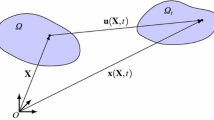Abstract
A method is proposed for numerical calculation of complex systems of partial and ordinary differential equations, based on the use of the integral Laplace and Fourier transform.
Similar content being viewed by others
Abbreviations
- T:
-
temperature
- V:
-
rate of motion of the heat-exchange agent
- α1 :
-
heat-transfer coefficient
- II1 :
-
perimeter of the heat-exchange agent channel
- c1 :
-
specific heat capacity of the heat-exchange agent
- ρ1 :
-
density
- g:
-
acceleration due to gravity
- S1 :
-
area of the transverse cross section of the heat-exchange agent channel
- x and y:
-
spatial coordinates
- τ:
-
time
- a1 :
-
thermal diffusivity
- ν :
-
relative insulation area
- c2 :
-
specific heat capacity of the wall
- ρ2 :
-
density of the wall
- r:
-
thermal resistance of the insulation
- q:
-
specific heat flux
- ɛ:
-
emissivity
- σo :
-
Stefan-Boltzmann constant
- Fw, i:
-
area of the transverse cross section of the duct wall
- kse :
-
coefficient of amplification of the sensing element
- Tse :
-
time constant for the sensing element
- U:
-
voltage
- kdr :
-
drive amplification coefficient
- Tdr :
-
drive time constant
- klfr :
-
coefficient for amplification of the liquid flow regulator
- G:
-
weight flow rate of the heat-transfer agent
- \(\bar \phi \) :
-
relative deviation of the regulator
- k8 = (dq2/dT3)o;k9 = (dq2/dT8)o;k10 = (dq2/dG2)o :
-
coefficient of sensitivity for liquid-liquid heat exchanger according to the input parameters
- τo,j:
-
time spent by the heat-transfer agent in the j-th element
- mj :
-
mass of the heat-transfer agent in the j-th element: k17 = (dq4/dT10)o
- k18 = (dq4/dT6)o :
-
coefficient of sensitivity of the gas-liquid heat-exchange agent according to the input parameters) W, transfer function
- d:
-
ducts
- w:
-
walls
- se:
-
sensing elements
- dr:
-
drive
- 1fr:
-
liquid flow regulator
Literature cited
E. G. Dudnikov and M. P. Simoyu, “Models, mathematical methods and computational technology for control,” Vopr. Prom, Kibern., No. 27, 70–73 (1970).
F. A. Vul'man and N. S. Khor'kov, Heat Computer Calculations for Heat Energy Installations [in Russian], Énergiya, Moscow (1975), p. 199.
Author information
Authors and Affiliations
Additional information
Translated from Inzhenerno-Fizicheskii Zhurnal, Vol. 39, No. 4, pp. 699–703, October, 1980.
Rights and permissions
About this article
Cite this article
Baloban, V.I., Guseva, V.N., Korolev, S.I. et al. Application of frequency methods for studying nonstationary regimes in the functioning of heat-engineering systems. Journal of Engineering Physics 39, 1121–1124 (1980). https://doi.org/10.1007/BF00822148
Received:
Issue Date:
DOI: https://doi.org/10.1007/BF00822148




